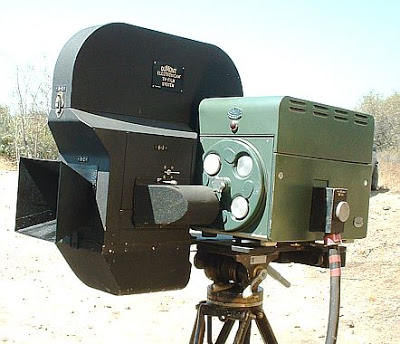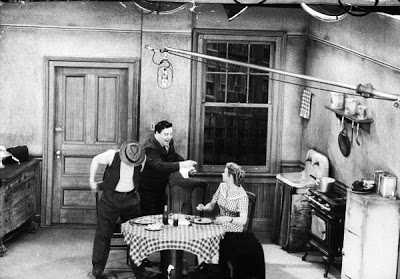Philosophy


Television network DuMont's Electronicam, used on the The Honeymooners and Captain Video, was a revolution in film recording.
Wikipedia...
Electronicam was a television recording system that shot an image on film and television at the same time through a common lens. It was developed by James L. Caddigan for the DuMont Television Network in the 1950s, before electronic recording on videotape was available. Since the film directly captured the live scene, its quality was much higher than the commonly-used kinescope films, which were shot from a TV screen.
How it worked...
The schematic for the Electronicam is fairly simple. The image passes through a lens into a beam splitter that sends half the light to a 35 mm or 16 mm camera mounted on the right side of the television camera. The other half of the light passes to the other side, through a 45-degree angle mirror and into a video camera tube. Because the camera dollies had to support two cameras—one conventional electronic orthicon tube TV camera, and one 35mm motion picture camera—the system was bulky and heavy, and somewhat clumsy in operation. This made complex productions problematic. Single-stage shows, such as Jackie Gleason's Honeymooners, were relatively easy since they had few sets and generally small casts.
In the studio, when two or three Electronicam cameras were used, a kinescope system recorded the live feed (as broadcast), so the Electronicam films could later be edited to match. The audio was recorded separately, onto either a magnetic fullcoat or as an optical soundtrack negative.
Usage...
The "classic 39" episodes of The Honeymooners were shot with Electronicams, which meant they could be rerun on broadcast TV, and eventually transferred to home video. Without Electronicams, almost all The Honeymooners episodes would no longer be available, as most DuMont kinescope recordings were destroyed in the 1970s.
Also, around 1956 British producer Joseph Arthur Rank brought three Electronicams to the United Kingdom to experiment with, but eventually, he was disappointed with the picture quality.
The DuMont ELECTRONICAM
DuMont Television Network
- The Feast Of Saint Jackie
My Fellow Comedists, A quick note to those who didn't see this item in the bulletin, but I will be appearing at Magooby's Joke House in Baltimore on Sunday. Show starts at 8 and I've got a new set, so would be great to see people there. This...
- High-speed Photography Going The Way Of Eastman Kodak
Betty Giles with Model 112 camera. "Beloved High-Speed Film Camera Faces Extinction" by Jakob Schiller August 22nd, 2012 Wired For more than five decades, the Charles A. Hulcher Co. filled an important niche in the camera world. Their cameras, which...
- A Hasselbland Pin Hole Camera
A fine through the lens 2-1/4 X 2-1/4 camera. Pricey and nearly extinct now. "Beautiful Cardboard Hasselblad Almost as Well Made As Real Thing" by Charlie Sorrel March 29th, 2011 Wired Yes, you could make a pinhole camera from a shoebox. In fact,...
- Deceased--thomas T. Goldsmith Jr.
Thomas T. Goldsmith Jr. January 9th, 1910 to March 5th, 2009 "Thomas T. Goldsmith Jr., a TV Technology Pioneer, Dies at 99" by Dennis Hevesi March 14th, 2009 The New York Times Thomas T. Goldsmith Jr., a pioneer of television technology who with his...
- "oscar" Science
Oscar will be here soon [February 22nd] and it is interesting to note the huge anount of physics and chemistry involved in the production of motion pictures. Probably 99% of the movie goers could care less about the technical side of making movies but...
Philosophy
Foresight and the "electronicam"


Television network DuMont's Electronicam, used on the The Honeymooners and Captain Video, was a revolution in film recording.
Wikipedia...
Electronicam was a television recording system that shot an image on film and television at the same time through a common lens. It was developed by James L. Caddigan for the DuMont Television Network in the 1950s, before electronic recording on videotape was available. Since the film directly captured the live scene, its quality was much higher than the commonly-used kinescope films, which were shot from a TV screen.
How it worked...
The schematic for the Electronicam is fairly simple. The image passes through a lens into a beam splitter that sends half the light to a 35 mm or 16 mm camera mounted on the right side of the television camera. The other half of the light passes to the other side, through a 45-degree angle mirror and into a video camera tube. Because the camera dollies had to support two cameras—one conventional electronic orthicon tube TV camera, and one 35mm motion picture camera—the system was bulky and heavy, and somewhat clumsy in operation. This made complex productions problematic. Single-stage shows, such as Jackie Gleason's Honeymooners, were relatively easy since they had few sets and generally small casts.
In the studio, when two or three Electronicam cameras were used, a kinescope system recorded the live feed (as broadcast), so the Electronicam films could later be edited to match. The audio was recorded separately, onto either a magnetic fullcoat or as an optical soundtrack negative.
Usage...
The "classic 39" episodes of The Honeymooners were shot with Electronicams, which meant they could be rerun on broadcast TV, and eventually transferred to home video. Without Electronicams, almost all The Honeymooners episodes would no longer be available, as most DuMont kinescope recordings were destroyed in the 1970s.
Also, around 1956 British producer Joseph Arthur Rank brought three Electronicams to the United Kingdom to experiment with, but eventually, he was disappointed with the picture quality.
The DuMont ELECTRONICAM
DuMont Television Network
- The Feast Of Saint Jackie
My Fellow Comedists, A quick note to those who didn't see this item in the bulletin, but I will be appearing at Magooby's Joke House in Baltimore on Sunday. Show starts at 8 and I've got a new set, so would be great to see people there. This...
- High-speed Photography Going The Way Of Eastman Kodak
Betty Giles with Model 112 camera. "Beloved High-Speed Film Camera Faces Extinction" by Jakob Schiller August 22nd, 2012 Wired For more than five decades, the Charles A. Hulcher Co. filled an important niche in the camera world. Their cameras, which...
- A Hasselbland Pin Hole Camera
A fine through the lens 2-1/4 X 2-1/4 camera. Pricey and nearly extinct now. "Beautiful Cardboard Hasselblad Almost as Well Made As Real Thing" by Charlie Sorrel March 29th, 2011 Wired Yes, you could make a pinhole camera from a shoebox. In fact,...
- Deceased--thomas T. Goldsmith Jr.
Thomas T. Goldsmith Jr. January 9th, 1910 to March 5th, 2009 "Thomas T. Goldsmith Jr., a TV Technology Pioneer, Dies at 99" by Dennis Hevesi March 14th, 2009 The New York Times Thomas T. Goldsmith Jr., a pioneer of television technology who with his...
- "oscar" Science
Oscar will be here soon [February 22nd] and it is interesting to note the huge anount of physics and chemistry involved in the production of motion pictures. Probably 99% of the movie goers could care less about the technical side of making movies but...
